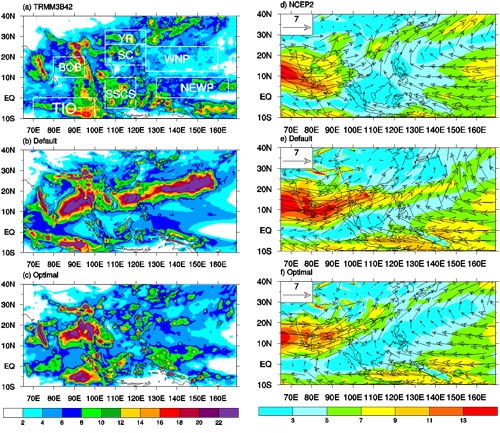Parameter tuning in a regional climate model
Date:2014-10-22
Tunable parameters are used in the climate model parameterization schemes. Adjustments of parameter values are often needed to better match model simulations with observations. Traditional sensitivity experiment is difficult to identify the optimal parameter sets in the model physics and quantify the interaction among multiple parameters, because each time only one parameter is perturbed. The multiple very fast simulated annealing (MVFSA) algorithm is a stochastic importance sampling algorithm that can progressively and efficiently move toward regions of the parameter space that minimize model-observation differences. Scientists of Institute of Atmospheric Physics (IAP) employed this method to calibrate the performance of the Regional Climate Model, version 3 (RegCM3) with the Massachusetts Institute of Technology (MIT)–Emanuel cumulus parameterization scheme over the Coordinated Regional Climate Downscaling Experiment (CORDEX) East Asia domain by tuning seven selected parameters.
The results showed the simulated spatial pattern of rainfall (Left panel of Fig.1) and the probability density function distribution of daily rainfall rates were significantly improved in the optimal simulation. The identified optimal parameters constrained by total rainfall had positive effects on the low-level circulation (Right panel of Fig.1) and surface air temperature. Furthermore, the optimized parameters based on the chosen extreme case were transferable to a normal case and the model’s new version with mixed convection scheme. These results highlighted the usefulness of the MVFSA approach in calibrating the performance of climate models.
These results were recently published in Journal of Climate.

Reference:
Zou, L., Y. Qian, T. Zhou, and B. Yang, 2014: Parameter Tuning and Calibration of RegCM3 with MIT–Emanuel Cumulus Parameterization Scheme over CORDEX East Asia Domain. J. Climate, 27, 7687–7701.
Figure 1 Spatial distributions of precipitation (left panel, mm/day), and 850 hPa low-level wind and the associated wind speed (right panel, m/s) averaged from June to August 1998 derived from (a) TRMM3B42, (b) NCEP2, (c, d) the simulation with default parameters, and (e, f) the simulation with the identified optimal parameters.
